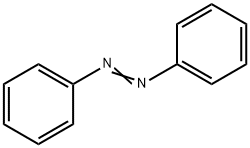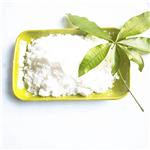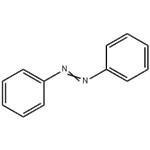Description
Azobenzene is a well-known derivative of stimulus-responsive molecular switches and has shown superior performance as a functional material in biomedical applications.
Azobenzene is a typical photo-responsive molecule that isomerizes from its planar trans-form to the non-planar cis-form after UV-light irradiation with a wavelength between 300 nm and 400 nm (lmax is around 330 nm). Interestingly, the system reverts from the cis-form to the trans-form after further irradiation with visible light (wavelength over 400 nm). This process is completely reversible, and the azobenzene group does not decompose or induce undesirable side reactions even on repeated trans-cis isomerization. By introducing azobenzenes into DNA through D-threoninol as a linker, Asanuma and co-workers succeeded in achieving photo-regulation of:
Formation and dissociation of a DNA duplex
Transcription by T7-RNA polymerase reaction
Chemical Properties
orange to red crystals
Chemical Properties
Azobenzene is a combustible, orange-red
crystalline solid.
Uses
Impurity in the production of Phenylbutazone (P319570).
Uses
acaricide, insecticide.
Azobenzene can be used as an optical trigger for the design and synthesis of a large variety of photoresponsive systems.
Uses
Precursor for dyes, for polymers.
Definition
ChEBI: A molecule whose structure comprises two phenyl rings linked by a N=N double bond; the parent compound of the azobenzene class of compounds.
General Description
Orange-red crystals or dark brown chunky solid.
Air & Water Reactions
AZOBENZENE is sensitive to air and light. Dust may form an explosive mixture in air. Insoluble in water.
Reactivity Profile
AZOBENZENE is an azo compound. Azo, diazo, azido compounds can detonate. This applies in particular to organic azides that have been sensitized by the addition of metal salts or strong acids. Toxic gases are formed by mixing materials of this class with acids, aldehydes, amides, carbamates, cyanides, inorganic fluorides, halogenated organics, isocyanates, ketones, metals, nitrides, peroxides, phenols, epoxides, acyl halides, and strong oxidizing or reducing agents. Flammable gases are formed by mixing materials in this group with alkali metals. Explosive combination can occur with strong oxidizing agents, metal salts, peroxides, and sulfides. AZOBENZENE is incompatible with strong oxidizing agents.
Hazard
Toxic; may cause liver injury. Questionable
carcinogen.
Fire Hazard
Flash point data for AZOBENZENE are not available. AZOBENZENE is probably combustible.
Safety Profile
Moderately toxic by
ingestion and possibly other routes.
Questionable carcinogen with experimental
carcinogenic, neoplastigenic, and
tumorigenic data. When heated to
decomposition it emits toxic fumes of NOx.
Potential Exposure
An azo compound. Those engaged in
azobenzene use in dye, rubber, chemical, and pesticide
manufacturing.
First aid
If this chemical gets into the eyes, remove anycontact lenses at once and irrigate immediately for at least15 min, occasionally lifting upper and lower lids. Seek medical attention immediately. If this chemical contacts theskin, remove contaminated clothing and wash immediatelywith soap and water. Seek medical attention immediately. Ifthis chemical has been inhaled, remove from exposure,begin rescue breathing (using universal precautions, including resuscitation mask) if breathing has stopped and CPR ifheart action has stopped. Transfer promptly to a medicalfacility. When this chemical has been swallowed, get medical attention. Give large quantities of water and inducevomiting. Do not make an unconscious person vomit.
storage
lor Code—Blue: Health Hazard/Poison: Storein a secure poison location. Prior to working with thischemical you should be trained on its proper handling andstorage. Store under an inert atmosphere in a freezer orAzobenzene 301refrigerator. Protect from air and light. Sources of ignition, such as smoking and open flames, are prohibitedwhere this chemical is used, handled, or stored in a mannerthat could create a potential fire or explosion hazard. Aregulated, marked area should be established where thischemical is handled, used, or stored in compliance withOSHA Standard 1910.1045.
Shipping
UN2811 Toxic solids, organic, n.o.s., Hazard
Class: 6.1; Labels: 6.1-Poisonous materials, Technical
Name Required.
Purification Methods
Ordinary azobenzene is nearly all in the trans-form. It is partly converted into the cis-form on exposure to light [for isolation see Hartley J Chem Soc 633 1938, and for spectra of cis-and trans-azobenzenes, see Winkel & Siebert Chem Ber 74B 6701941]. trans-Azobenzene is obtained by chromatography on alumina using 1:4 *C6H6/heptane or pet ether, and it crystallises from EtOH (after refluxing for several hours) or hexane. All operations should be carried out in diffuse red light or in the dark. [Beilstein 16 IV 8.]
Incompatibilities
Azo compounds can detonate. This
applies in particular to organic azides that have been sensitized
by the addition of metal salts or strong acids.
Toxic gases are formed by mixing materials of this class
with acids, aldehydes, amides, carbamates, cyanides,
inorganic fluorides, halogenated organics, isocyanates,
ketones, metals, nitrides, peroxides, phenols, epoxides,
acyl halides, and strong oxidizing or reducing agents.
Flammable gases are formed by mixing materials in this
group with alkali metals. Explosive combination can occur
with strong oxidizing agents, metal salts, peroxides, and
sulfides. This chemical is sensitive to prolonged exposure
to heat. This chemical is incompatible with strong oxidizing
agents.
Toxics Screening Level
The Initial Risk Screening Level (IRSL) for azobenzene is 0.03 μg/m3 based on an annual averaging time.






